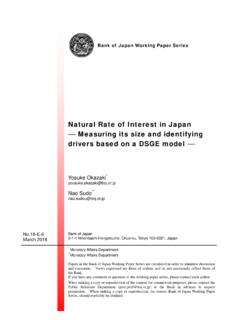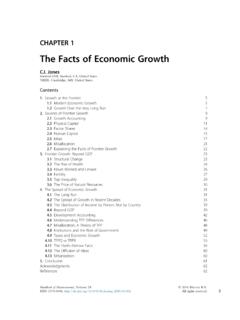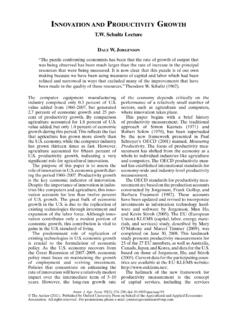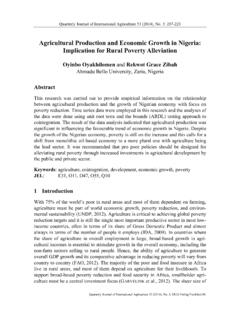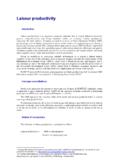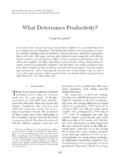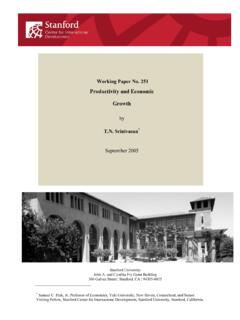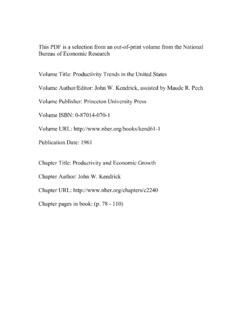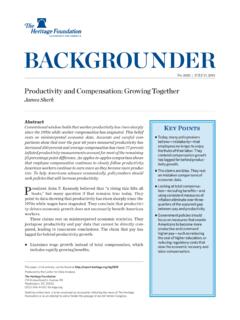Transcription of Productivity Improvement and Economic Growth - boj.or.jp
1 Productivity Improvement and Economic Growth Koji Nakamura* Sohei Kaihatsu** Tomoyuki Yagi** May 2018 Bank of Japan 2-1-1 Nihonbashi-Hongokucho, Chuo-ku, Tokyo 103-0021, Japan * Research and Statistics Department (currently Matsumoto Branch) ** Research and Statistics Department ** Research and Statistics Department (currently Monetary Affairs Department) Papers in the Bank of Japan Working Paper Series are circulated in order to stimulate discussion and comments. Views expressed are those of authors and do not necessarily reflect those of the Bank. If you have any comment or question on the working paper series, please contact each author. When making a copy or reproduction of the content for commercial purposes, please contact the Public Relations Department at the Bank in advance to request permission.
2 When making a copy or reproduction, the source, Bank of Japan Working Paper Series, should explicitly be credited. Bank of Japan Working Paper Series 1 Productivity Improvement and Economic Growth * Koji Nakamura Sohei Kaihatsu Tomoyuki Yagi May 2018 Abstract This paper summarizes recent discussion on labor Productivity which is the source of medium- to long-term Economic Growth and observes the characteristics of recent Productivity developments using relevant statistical data. Furthermore, the paper examines the background of recent Japan's low labor Productivity Growth and analyzes issues regarding Japan's sustainable Growth . Labor Productivity in major advanced countries has been experiencing a slowdown in recent years.
3 This is mainly affected by the slowdown of Total Factor Productivity (TFP). In Japan, there are two reasons behind the slowdown: first, technology and ideas accumulated by research and development (R&D) and management resources such as capital and labor are not utilized efficiently; and second, these resources are not efficiently reallocated among corporations. In order to improve Japan's Productivity in the medium to long-term, it is desirable to encourage the flexible reallocation of management resources such as capital and labor by changing working process at the corporate level in accordance with changes in the socio- Economic environment and the advent of new technologies, as well as by improving efficiency in the labor and capital markets.
4 JEL Classification: E20, O30, O47 Keywords: Productivity , Potential Growth , Intangible assets, Resource reallocation * We would like to thank Kosuke Aoki, Hibiki Ichiue, Seisaku Kameda, Ryo Kato, Nobuyuki Kinoshita, Yoichi Matsubayashi, Toshitaka Sekine, Tomohiro Sugo, and Toshinao Yoshiba as well as the staff of the Bank of Japan for their helpful comments. We also thank Wakako Kaku for assisting the data compilation as well as Chikako Wakasa and Lisa Uemae for helping with English translation. The opinions expressed here, as well as any remaining errors, are those of the authors and should not be ascribed to the Bank of Japan. Research and Statistics Department (currently Matsumoto Branch), Bank of Japan (E-mail: Research and Statistics Department, Bank of Japan (E-mail: Research and Statistics Department (currently Monetary Affairs Department), Bank of Japan (E-mail: 2 1.)))
5 Introduction Japan's rapid aging and shrinking population has and will continue to contribute to a decrease in labor input and a slowdown in the Economic Growth rate. Based on these demographics, in order to encourage Japan's sustainable Growth , it is necessary to increase the labor participation rate and labor Productivity . In terms of the labor participation rate, it is possible to raise the rate to a certain extent by enhancing incentives for women and seniors to work, but there is a limit to any increase through this method alone. Considering the limitations, labor Productivity will play an essential role for medium- to long-term Growth in Japan. This paper summarizes recent discussion on labor Productivity and examines the challenges of its sustainable Improvement for medium- to long-term Growth in Japan based on empirical analysis.
6 Specifically, we analyze several factors which affect the sustainable Growth of labor Productivity after confirming that labor Productivity has an effect on the nation's medium- to long-term Economic Growth . Based on these factors, we then examine the issues of sustainable Growth at the Japanese company level, which leads to issues at the national level. We touch upon the relationship between the theme of this paper and discussions of "secular stagnation," a phenomenon recently observed in advanced countries. It has become clear that Economic Growth rates not only in Japan but also in many other advanced countries are on downward trends, and there have been many discussions on the causes of these trends (Chart 1).
7 1 The series of discussions on secular stagnation can be roughly divided into two streams, by focusing on either the demand-side or supply-side. Summers (2013), providing a representative discussion on the demand-side, insists that traditional monetary policy cannot provide Economic stimulus sufficiently facing the zero lower bound on nominal interest rates under the negative natural rate of interest, and thus, as total demand continues to be below total supply, the economy falls into secular stagnation. On the other hand, Gordon (2015), providing a representative discussion on the supply-side, mentions that secular stagnation is caused by the lack of innovative technologies which are the source of the Economic Growth .
8 These arguments are not exclusive, but rather interact with each other, each exerting a negative influence on the national economy over differing time horizons. Labor Productivity , as analyzed in this paper, shows the concept of output efficiency and thus is directly related to 1 See, for example, Coen and Baldwin (2014) and Nakano and Kato (2017) who summarize the discussions on secular stagnation. 3 Gordon's supply-side discussion. Meanwhile, the natural rate of interest which plays a vital role for the demand-side discussion, under certain conditions, is the concept that corresponds to a potential Growth rate the Growth rate of potential GDP indicating aggregate supply hence discussions of both demand-side and supply-side are closely tied to each other in the medium to ,3 From this perspective, any analysis of changes in labor Productivity and the determinants of its movement supplements the series of discussions regarding secular stagnation over recent years.
9 The rest of the paper proceeds as follows. In Section 2, we observe the trends of labor Productivity and related indicators in each country. Section 3 gives an overview of the arguments regarding the global slowdown in the Growth rate of labor Productivity . In Section 4, we focus on Japan's labor Productivity in recent years and examine the background of its sluggishness. Section 5 is the conclusion. 2. Labor Productivity in Major Advanced Countries Labor Productivity provides a measure of the efficiency with which one unit of labor input can produce goods and services and can be measured in various It is calculated by dividing output by total employment (head count), giving 'output per worker,' and is also calculated by the total number of hours worked, giving 'output per hour worked.
10 ' Recent Growth rates in major advanced countries (Japan, the Germany) calculated with either of these measurements have declined (Chart 2). From the view point of producers, labor Productivity is the measurement of value created by one worker. In order to consider how much value is distributed to an individual person, it is appropriate to use the value calculated by dividing output by total population, output per capita. This gives the 'standard of living per person,' the Growth rates of which have declined in major advanced countries in recent years, in the same trend as other labor Productivity measures, as mentioned above (Chart 3). This result is obvious since total population and the number of workers move almost proportionally in the long-term.







